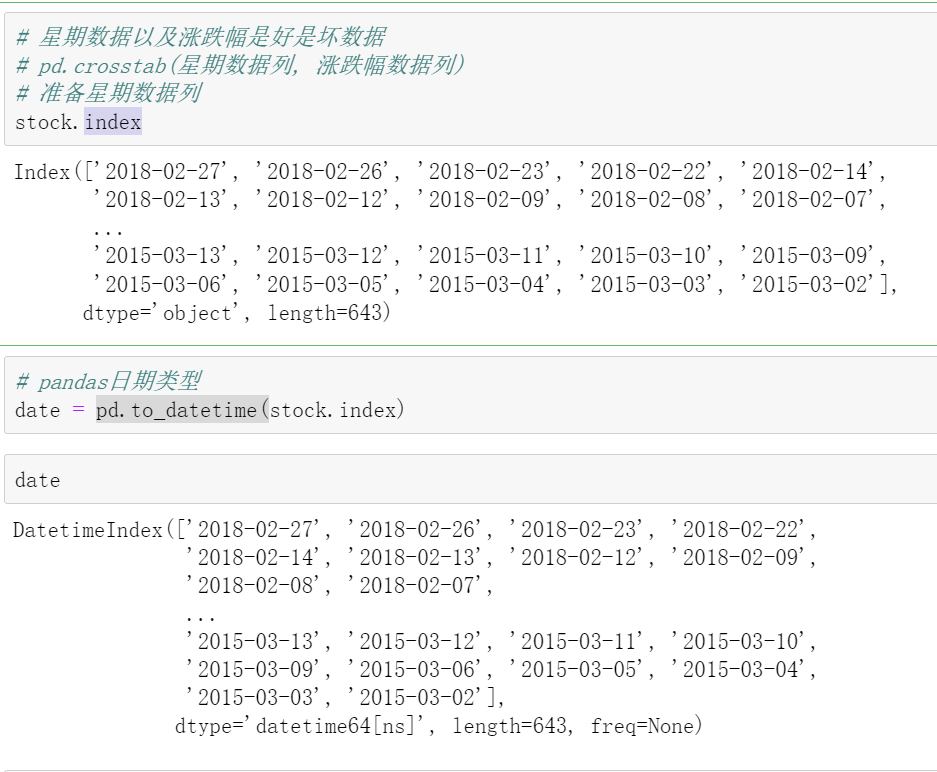python和TensorFlow中一些常用小知识
1.format格式化输出
看看找个小例子是格式化输出+正则表达式赋值的
t=["11点{}分".format(i) for i in range(60)]
print(t)
['11点0分', '11点1分', '11点2分', '11点3分', '11点4分', '11点5分', '11点6分', '11点7分', '11点8分', '11点9分', '11点10分', '11点11分', '11点12分', '11点13分', '11点14分', '11点15分', '11点16分', '11点17分', '11点18分', '11点19分', '11点20分', '11点21分', '11点22分', '11点23分', '11点24分', '11点25分', '11点26分', '11点27分', '11点28分', '11点29分', '11点30分', '11点31分', '11点32分', '11点33分', '11点34分', '11点35分', '11点36分', '11点37分', '11点38分', '11点39分', '11点40分', '11点41分', '11点42分', '11点43分', '11点44分', '11点45分', '11点46分', '11点47分', '11点48分', '11点49分', '11点50分', '11点51分', '11点52分', '11点53分', '11点54分', '11点55分', '11点56分', '11点57分', '11点58分', '11点59分']
构造的就是这样的
2.pandas中的时间序列
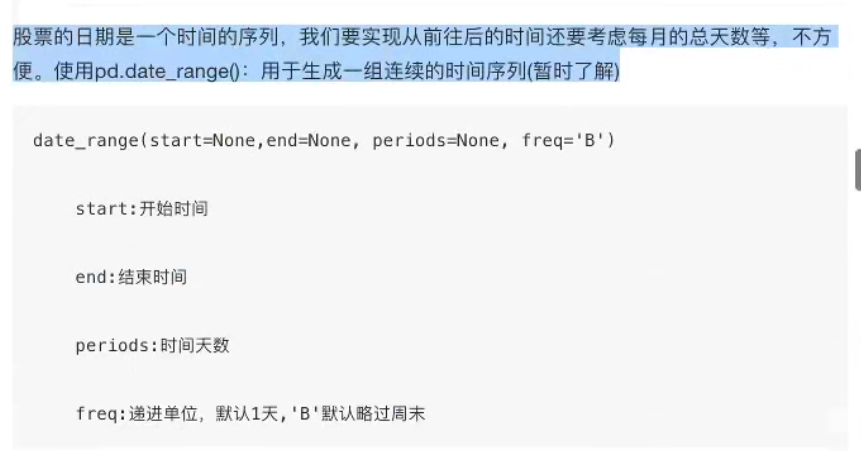
3.pandas把字符串转化为时间序列
pd.to_datetime()
然后你看这个就转化成了DatetimeIndex类型,这个类型有个好处的,直接date.month就可以返回对应的月份,直接date.weekday就可以直接返回对应的星期
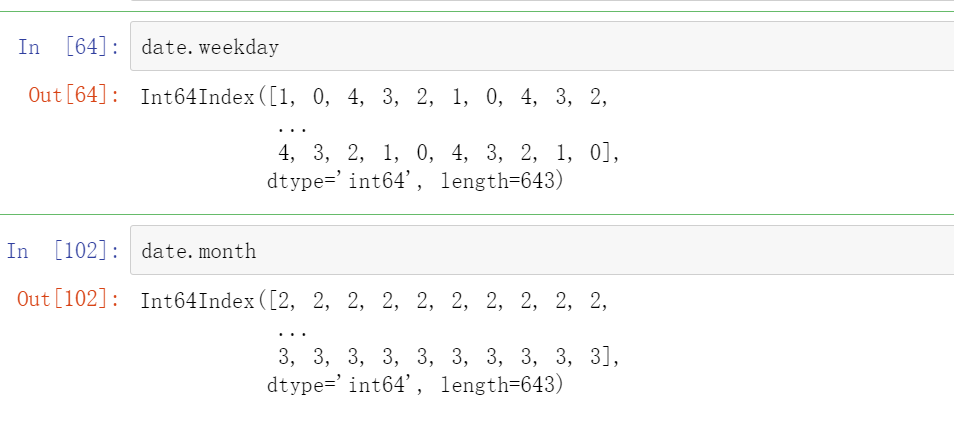
4 with---as 的用法
我们先看这段代码:
file = open("/tmp/foo.txt")
try:
data = file.read()
finally:
file.close()
然后用with----as表示就是:
with open("/tmp/foo.txt") as file:
data = file.read()
5 tf.random.shuffle()打散函数
tf.random.shuffle(idx)
这个就是原本idx中的数组打散,从新分配位置
例如:

6 tf.data.Dataset.from_tensor_slices()和batch()
1.tf.data.Dataset.from_tensor_slices()
该函数的作用是接收tensor,对tensor的第一维度进行切分,并返回一个表示该tensor的切片数据集

import tensorflow as tf
t = tf.range(10.)[:, None]
t = tf.data.Dataset.from_tensor_slices(t)
#<TensorSliceDataset shapes: (1,), types: tf.float32>
for i in t:
print(i.numpy())
# [0.]
# [1.]
# [2.]
# [3.]
# [4.]
# [5.]
# [6.]
# [7.]
# [8.]
# [9.]
2.batch()
这个类似于一个分组函数t.batch(3),就是把三个分成一组,在进行数据处理时通常于上面一个连用
import tensorflow as tf
t = tf.range(10.)[:, None]
t = tf.data.Dataset.from_tensor_slices(t)
#<TensorSliceDataset shapes: (1,), types: tf.float32>
for i in t:
print(i.numpy())
#[0.]
#[1.]
#[2.]
#[3.]
#[4.]
#[5.]
#[6.]
#[7.]
#[8.]
#[9.]
batch_t = t.batch(2)
#<BatchDataset shapes: (None, 1), types: tf.float32>
for i in batch_t:
print(i.numpy())
>>>
[[0.]
[1.]]
[[2.]
[3.]]
[[4.]
[5.]]
[[6.]
[7.]]
[[8.]
[9.]]
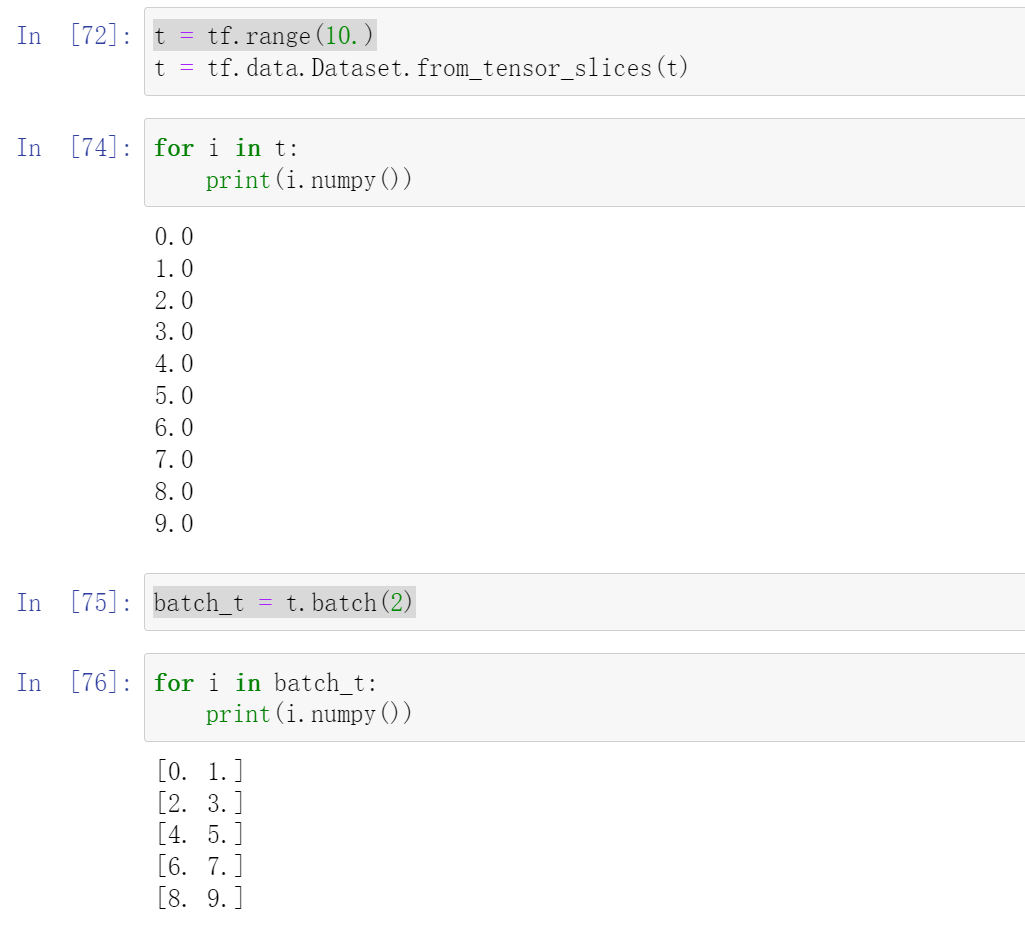
这两个函数通常连着用于数据处理:
dataset=tf.data.Dataset.from_tensor_slices([[1, 2], [3, 4],[5 , 6],[7 , 8]]).batch(2)
train_iter=iter(dataset)
sample=next(train_iter)
sample[0].shape,sample[1].shape
=>>(TensorShape([2]), TensorShape([2]))
for i in sample:
print(sample[0],sample[1])
=>tf.Tensor([1 2], shape=(2,), dtype=int32) tf.Tensor([3 4], shape=(2,), dtype=int32)
=>tf.Tensor([1 2], shape=(2,), dtype=int32) tf.Tensor([3 4], shape=(2,), dtype=int32)
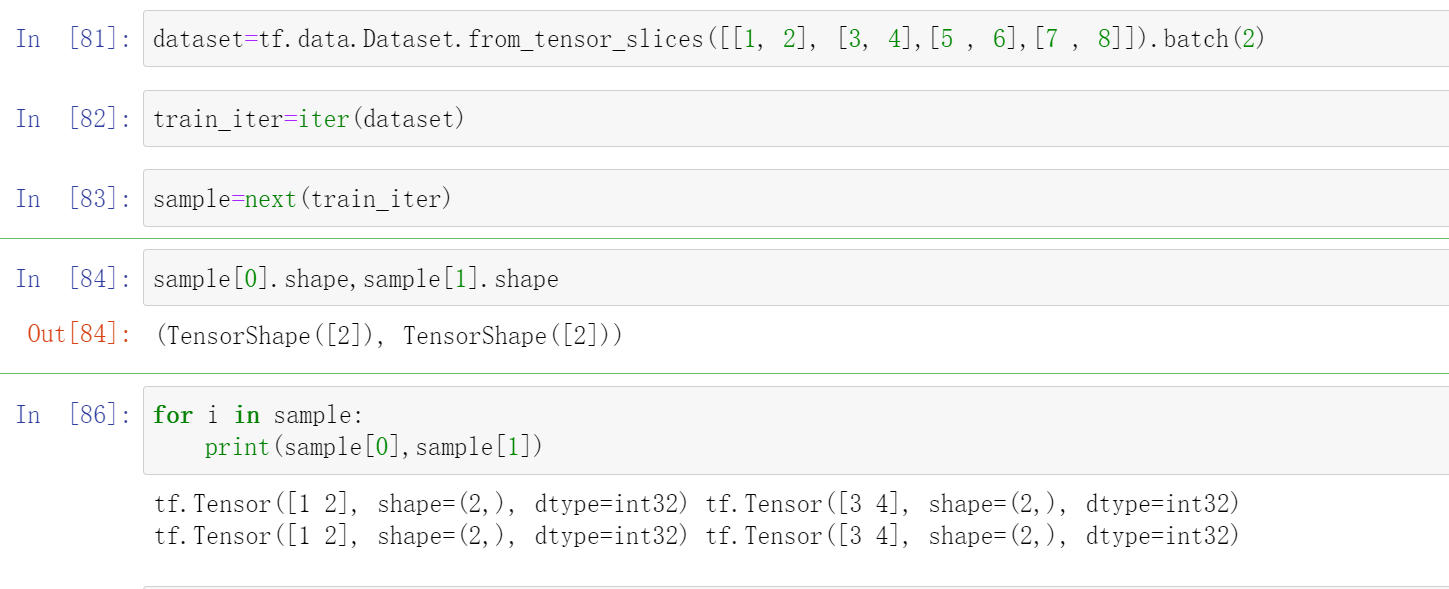
例如:
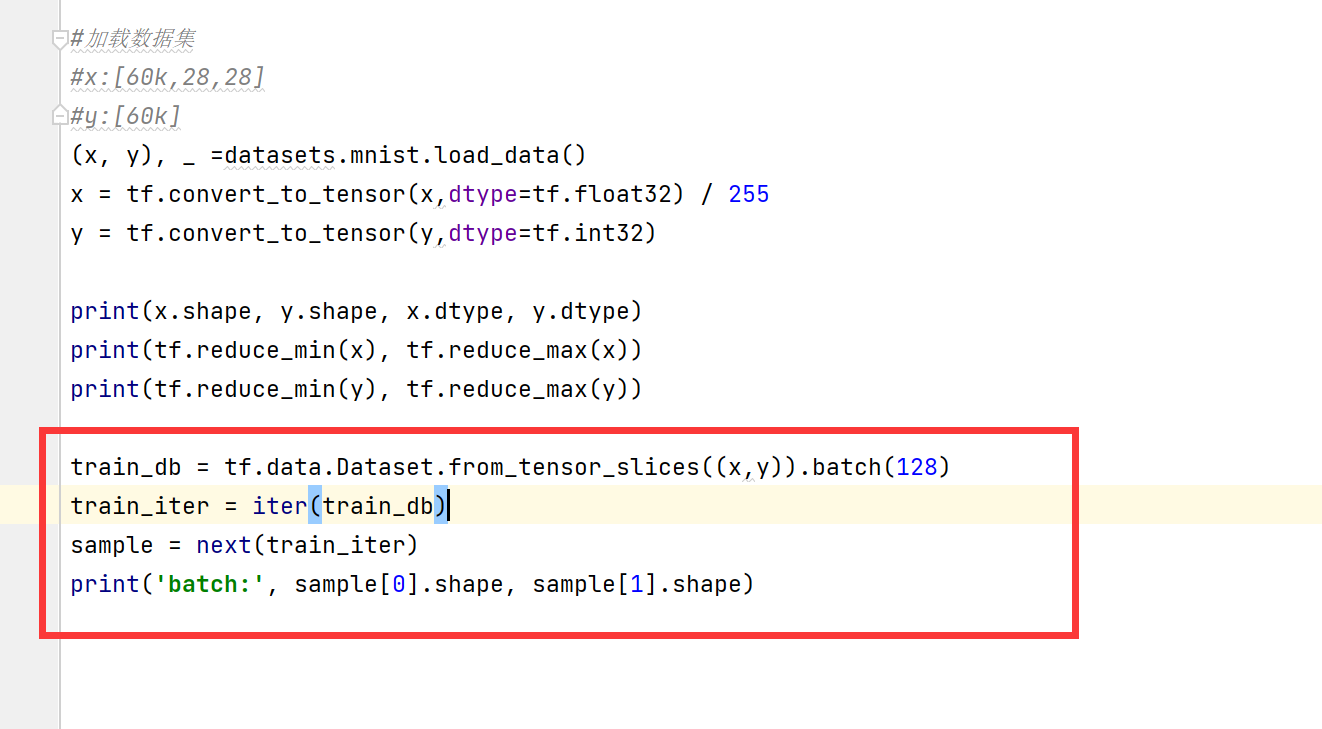
如果我们想访问的话可以这样:
dataset=tf.data.Dataset.from_tensor_slices([[1, 2], [3, 4],[5 , 6],[7 , 8]]).batch(2)
for i in dataset:
i=tf.reshape(i,[4])
print(i)
=>tf.Tensor([1 2 3 4], shape=(4,), dtype=int32)
=>tf.Tensor([5 6 7 8], shape=(4,), dtype=int32)

7 one_hot
这里
y_onehot = tf.one_hot(y, depth)
这里depth是分成几类
例如
y_onehot = tf.one_hot([0,1,2], depth=3)
y_onehot
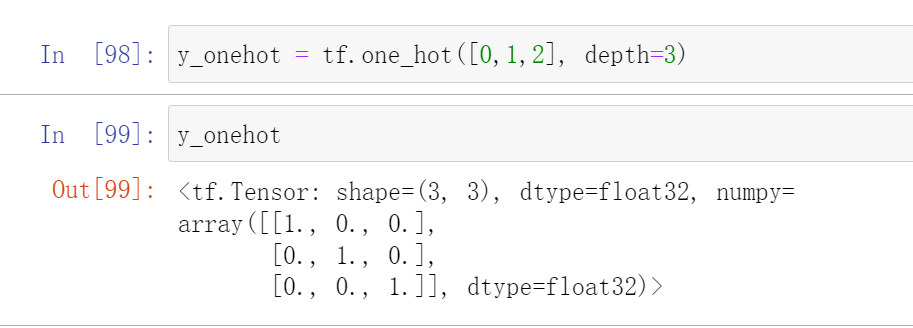
8 求导函数,tf.Variable和assign_sub()
我们在调用TensorFlow中的求导函数的时候
我们首先先用这个:
#定义:如果后面我们要跟踪w1,b1的梯度的话,我们首先要定义成Variable()类型
w1 = tf.Variable()
w2 = tf.Variable()
---
b3= tf.Variable()
with tf.GradientTape() as tape: # tf.Variable
#定义你的函数表达式
loss=------
grads = tape.gradient(loss, [w1, b1, w2, b2, w3, b3])
#在这里我们必须要把w1,b1,---b3定义成Variable要不然求的导数为空
#这里如果我们想保持w1,b1,w2,b2--的Variable的类型,我们需要用到assign_sub
#等价于w1=w1-lr*grads[0]
w1.assign_sub(lr * grads[0])
b1.assign_sub(lr * grads[1])
w2.assign_sub(lr * grads[2])
b2.assign_sub(lr * grads[3])
w3.assign_sub(lr * grads[4])
b3.assign_sub(lr * grads[5])
assign_sub函数常用于参数的自更新,等待更新的w,要先被指定为可更新可训练,也就是variable类型,才可以实现自更新
例如这个:
import os
os.environ['TF_CPP_MIN_LOG_LEVEL'] = '2'
import matplotlib
from matplotlib import pyplot as plt
# Default parameters for plots
matplotlib.rcParams['font.size'] = 20
matplotlib.rcParams['figure.titlesize'] = 20
matplotlib.rcParams['figure.figsize'] = [9, 7]
matplotlib.rcParams['font.family'] = ['STKaiTi']
matplotlib.rcParams['axes.unicode_minus']=False
import tensorflow as tf
from tensorflow import keras
from tensorflow.keras import datasets
# x: [60k, 28, 28],
# y: [60k]
(x, y), _ = datasets.mnist.load_data()
# x: [0~255] => [0~1.]
x = tf.convert_to_tensor(x, dtype=tf.float32) / 255.
y = tf.convert_to_tensor(y, dtype=tf.int32)
print(x.shape, y.shape, x.dtype, y.dtype)
print(tf.reduce_min(x), tf.reduce_max(x))
print(tf.reduce_min(y), tf.reduce_max(y))
train_db = tf.data.Dataset.from_tensor_slices((x,y)).batch(128)
train_iter = iter(train_db)
sample = next(train_iter)
print('batch:', sample[0].shape, sample[1].shape)
# [b, 784] => [b, 256] => [b, 128] => [b, 10]
# [dim_in, dim_out], [dim_out]
#这里要定义成Variable ,因为后面求偏导数的时候要跟踪他的梯度
w1 = tf.Variable(tf.random.truncated_normal([784, 256], stddev=0.1))
b1 = tf.Variable(tf.zeros([256]))
w2 = tf.Variable(tf.random.truncated_normal([256, 128], stddev=0.1))
b2 = tf.Variable(tf.zeros([128]))
w3 = tf.Variable(tf.random.truncated_normal([128, 10], stddev=0.1))
b3 = tf.Variable(tf.zeros([10]))
lr = 1e-3
losses = []
for epoch in range(20): # iterate db for 10
for step, (x, y) in enumerate(train_db): # for every batch
# x:[128, 28, 28]
# y: [128]
# [b, 28, 28] => [b, 28*28]
x = tf.reshape(x, [-1, 28*28])
with tf.GradientTape() as tape: # tf.Variable
# x: [b, 28*28]
# h1 = x@w1 + b1
# [b, 784]@[784, 256] + [256] => [b, 256] + [256] => [b, 256] + [b, 256]
h1 = x@w1 + tf.broadcast_to(b1, [x.shape[0], 256])
h1 = tf.nn.relu(h1)
# [b, 256] => [b, 128]
h2 = h1@w2 + b2
h2 = tf.nn.relu(h2)
# [b, 128] => [b, 10]
out = h2@w3 + b3
# compute loss
# out: [b, 10]
# y: [b] => [b, 10]
y_onehot = tf.one_hot(y, depth=10)
# mse = mean(sum(y-out)^2)
# [b, 10]
loss = tf.square(y_onehot - out)
# mean: scalar
loss = tf.reduce_mean(loss)
# compute gradients
grads = tape.gradient(loss, [w1, b1, w2, b2, w3, b3])
# print(grads)
# w1 = w1 - lr * w1_grad
w1.assign_sub(lr * grads[0])
b1.assign_sub(lr * grads[1])
w2.assign_sub(lr * grads[2])
b2.assign_sub(lr * grads[3])
w3.assign_sub(lr * grads[4])
b3.assign_sub(lr * grads[5])
if step % 100 == 0:
print(epoch, step, 'loss:', float(loss))
losses.append(float(loss))
plt.figure()
plt.plot(losses, color='C0', marker='s', label='训练')
plt.xlabel('Epoch')
plt.legend()
plt.ylabel('MSE')
plt.savefig('forward.svg')
# plt.show()
9 a[:2]==a[:2,:]
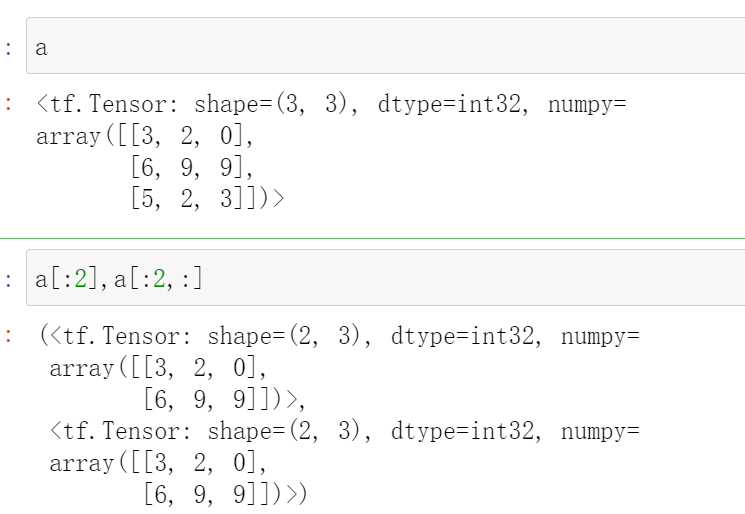
10 layers.Sequential不能用
今天下载了一个代码,运行的时候发现这个layers.Sequential报错
可能是不能用了

替换方法,变成了
keras.Sequential
就可以了
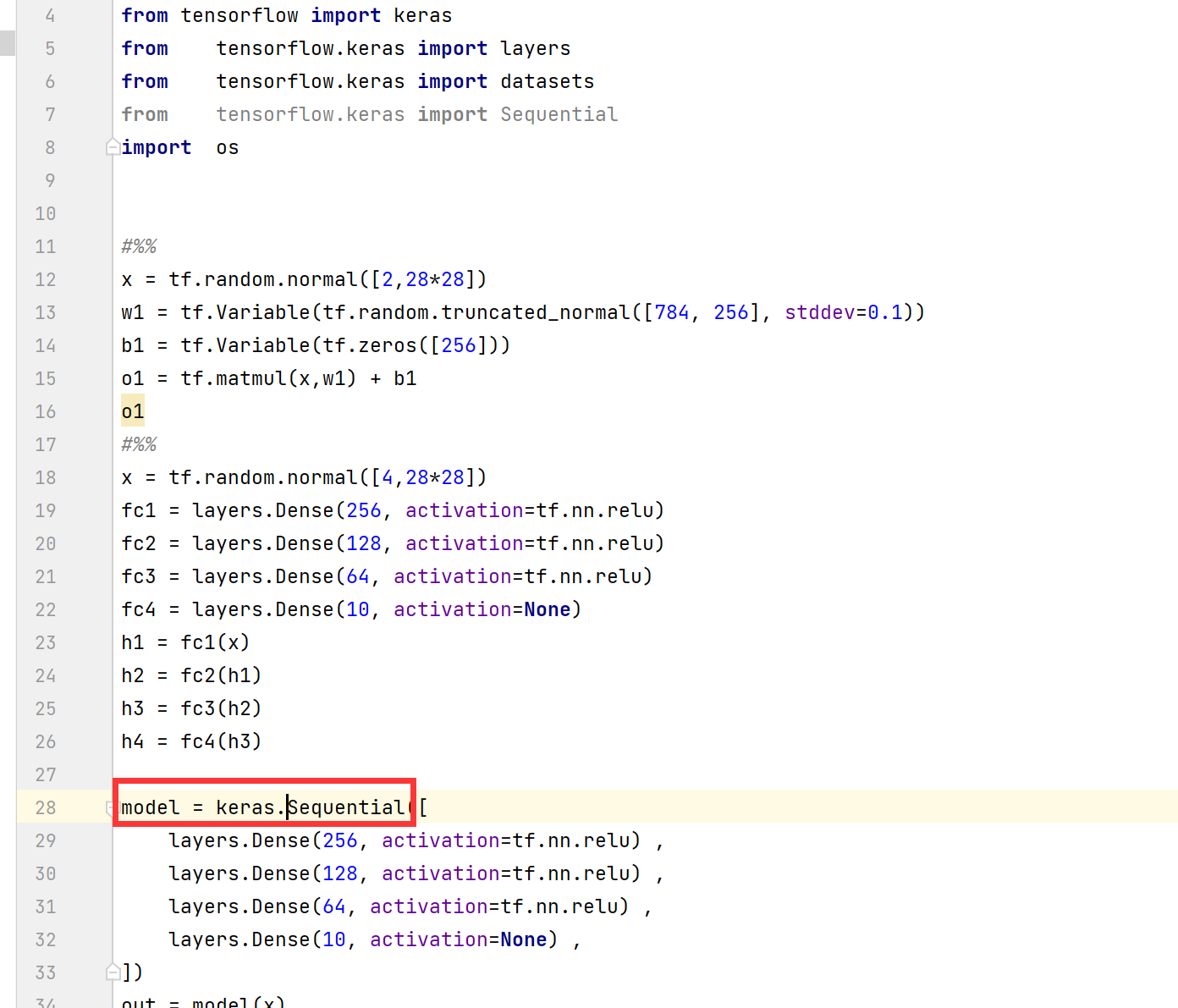
或者
from tensorflow.keras import Sequential
直接调用Sequential

